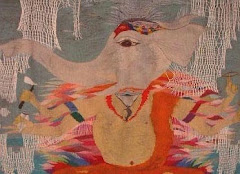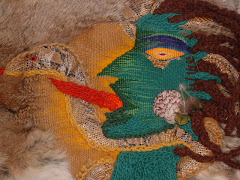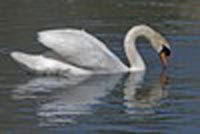Chapter Five
New Year’s Eve, 2004, 11:25 PM.
Thunder rumbles in the distance. Strange. Monsoon season was over months ago. The temple bell rings, summoning all of us. I dash down the ramp from my sixth floor flat, over the sand, through the iron gateways, and towards the ashram’s open-air auditorium behind the temple. Coconut palm fronds lash against each other in the wind. More thunder. Huge drops splash on my forehead. I make a run for it along the dimly lit grounds. Scattered groups dressed in white also rush along.
Water pounds the auditorium’s fiberglass roof and pelts palms, sounding like grain crashing through a silo. Thunder strikes again and again, in ear-shattering claps. The downpour blinds vision beyond the hall. A friend nudges up against me, eyes round. “It’s going to flood again. I know it.” I shrug. I hope not. As soon as the storm began I felt the rain was sent by the heavens to clean the grounds of sludge, to remove salt from the ocean’s flood five days ago when Arabian Sea water gushed across the narrow South Indian peninsula, flattening homes and tossing loris like toys in a bathtub. Now rain water is rising by inches, threatening to spill over into the hall.
After returning to the ashram just hours ago after our five-day stay in our refugee camp on the other side of the backwaters, I was shocked to see so much filth and debris littering the grounds—clothing, thongs, pieces of metal, bits of tattered palm frond huts, wood, plastic bags. The killer wave washed through the sewage pond spreading it over the grounds, sand now black with stink.
Now, at about five to midnight, someone brings Amma a mic. She leads us in the chant Lokaha Samasthaha Sukhino Bhanvantu—“May all of the beings in all the worlds be happy and peaceful.” For fifteen minutes we repeat the prayer. Tears stream down the eyes of some as our chanting echoes across the land. Waves pound in the distance. The downpour slows. Then stops. Water drips from the palm fronds. The wind calms.
Over the next days leaves on trees turn brown, dropping off, unable to survive the salt water soaking.
In the ashram everything had to be cleaned and scrubbed—water tanks, walls inside and out, temple ritual items, new books, press equipment, cassette tape covers, used clothing, thousands of stainless steel dinner plates, gift items for sale. Many computers were beyond repair. On my first day back from refugee camp, I wiped sludge off photos.
Teams were sent to clean up in the villages and to consol villagers. I jumped on a mini-bus moving out, filled with Indian ashram residents and a few Westerners, on the way down the ocean road to the worst-hit village. Buckets and shovels were propped behind the driver’s seat. I felt like a troubadour, finally going out to help in the field, no longer isolated in our refugee camp where one of my only hardships had been wearing the same clothes for five days, five days in tropical heat.
Now I clung to the pole at the open door of the bus, witnessing the devastation. Desolation—torn walls, flattened buildings, auto rickshaws tossed against palm trunks, trash burning in oil, villagers sitting, backs against beams that were once home. No one spoke on the van except to point now and then. When we arrived in the center of the village, we sat on the bus for about a half an hour and then returned to the ashram. The government officials would not let us work—some permits were required.
On subsequent days I’d heard that work in the field had moved forward unhindered, but I was not on the bus, because I never learned when or where. I settled with cutting vegetables, cleaning stainless steel plates and spoons, laundering used clothing. We left washed items in the sun for several days to purify. Monks and nuns spread new layers of white sand over the dried sludge.
Thousands of villagers lined up at the meal stands on the peninsula’s ocean road where food was served three times a day.
Medical care continued uninterrupted.
Men were at work building temporary shelters for over one hundred homeless families—to be ready in a few days. All to be equipped with running water, cooking stoves, and TV in a common room. Plans were underway for Amma’s ashram to rebuild village homes and new fishing boats, in many parts of India and Sri Lanka.
Amma would create jobs for fishermen, refurbishing damaged boats and building new ones. From the new fishing boats enough fish would be caught to feed several families a day. Job training for women who lost husbands would include tailoring and nursing. Men and women would be trained as emergency medical technicians and in computer technology.
Many private organizations provided ample food and shelter in various countries hit by the tsunami. With plenty food, shelter, and job training, there was minimal looting. Otherwise, there were countless stories of unbridled stealing.
All over the tsunami ravaged parts of Asia—Banda Ache, Indonesia; Thailand; Nagapattinam and Chennai, India; Andaman and Nicobar Islands; Sri Lanka—clean-up also took place. In Indonesia, for weeks workers wandered the countryside removing bodies. On the coast of India thousands of fishing boats lay splintered along the beach.
The clean-up and restoration would take years.
What is the message of the tsunami?
When Amma looks into nature, she sees that nature’s fury is not yet abated. Nature is still turbulent, agitated. Only the cool, gentle breeze of prayers can shift these dark clouds.
The tsunami was a warning, but nobody heard it. It is easy to wake up someone who is sleeping, but difficult to wake up someone who is pretending to be asleep. --Amma
All over the world over-use of nature continues unabated— air and water pollution, genetic engineering, threats to wildlife through oil drilling, clear-cutting forests, unheeded global climate change messages, sonar blasts killing sea life.
Some say greed is the cause for waste and depletion natural resources. Overpopulation is most likely the primary reason, and yet is not a well-advertised approach to the problem.
The tsunami was followed by the earthquake in China, the typhoon in Myanmar, the flooding in Louisiana from hurricane Katrina in the USA, and now in 2008, the flooding in the Midwest in the USA, and devastation from hurricanes Hannah and Ike in Texas, USA. In spite of the huge numbers of natural disasters happening all over the world, the people of Galveston, Texas, had not understood the power of nature—and most stayed to ride out the storm. In the aftermath, they found it impossible to live there as sewage was running down the streets; there was no electricity for cooking; many houses were flattened. Restoration of power would take weeks, clean-up perhaps years.
How many losses of land and city will it take before we catch on, before we return to our more human side, of caring for neighbors and friends and paying attention our intimate connection to nature. We cannot live without nature, and yet we continue to destroy her.
When I lived in Taos in the early ‘90’s the Hondo fire burned 8,000 acres, including sacred land. Many locals and natives referred to the natural disaster as The Great Smudge, referring to the Native American way of cleansing by smoke, burning branches of sage and sweet grass.
Nature knows well how to help us clean up the stage, in those times when we do not rise to the occasion.
 Galveston, Texas, after Hurrican Ike, 2008
Galveston, Texas, after Hurrican Ike, 2008photo of Galveston by US Geological Survey








No comments:
Post a Comment